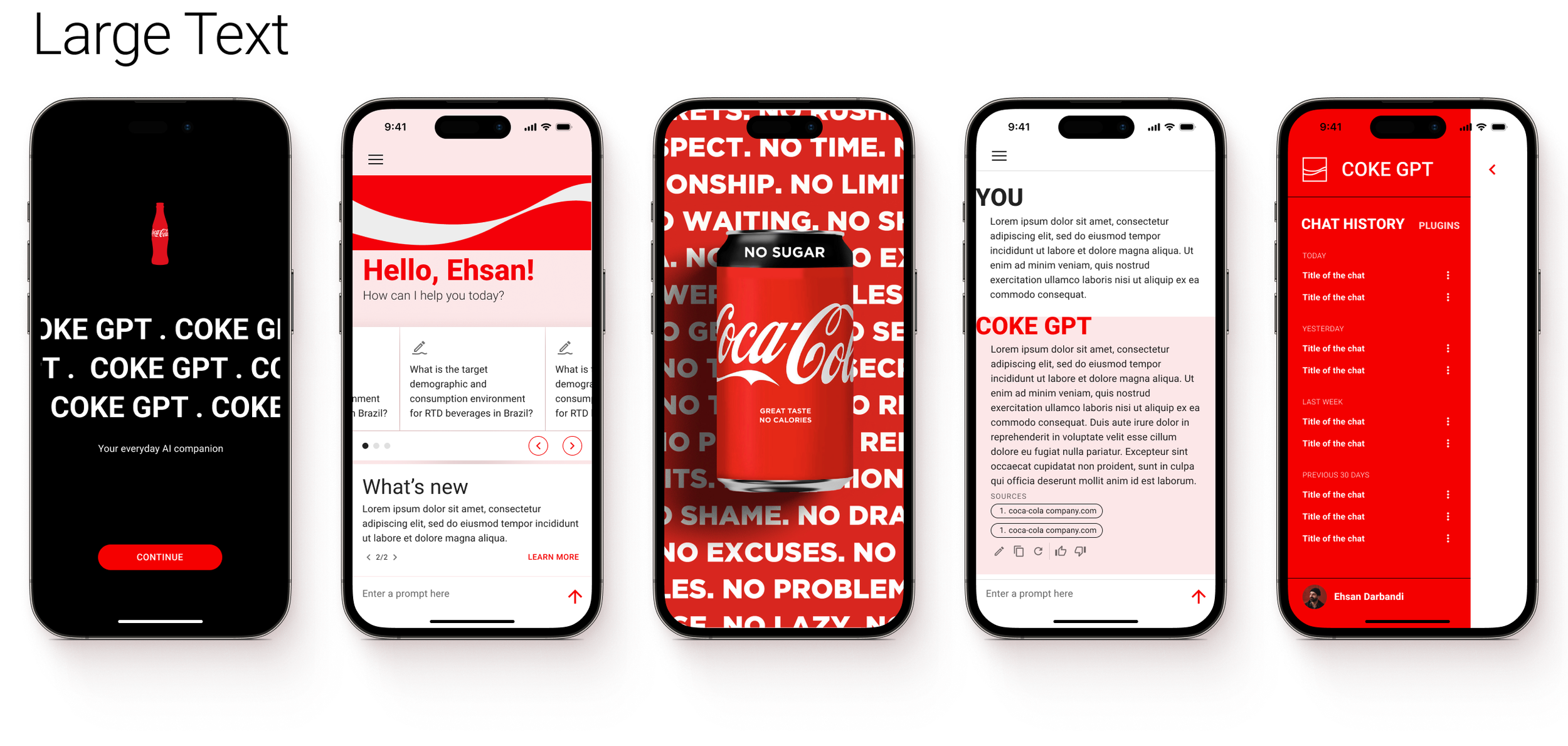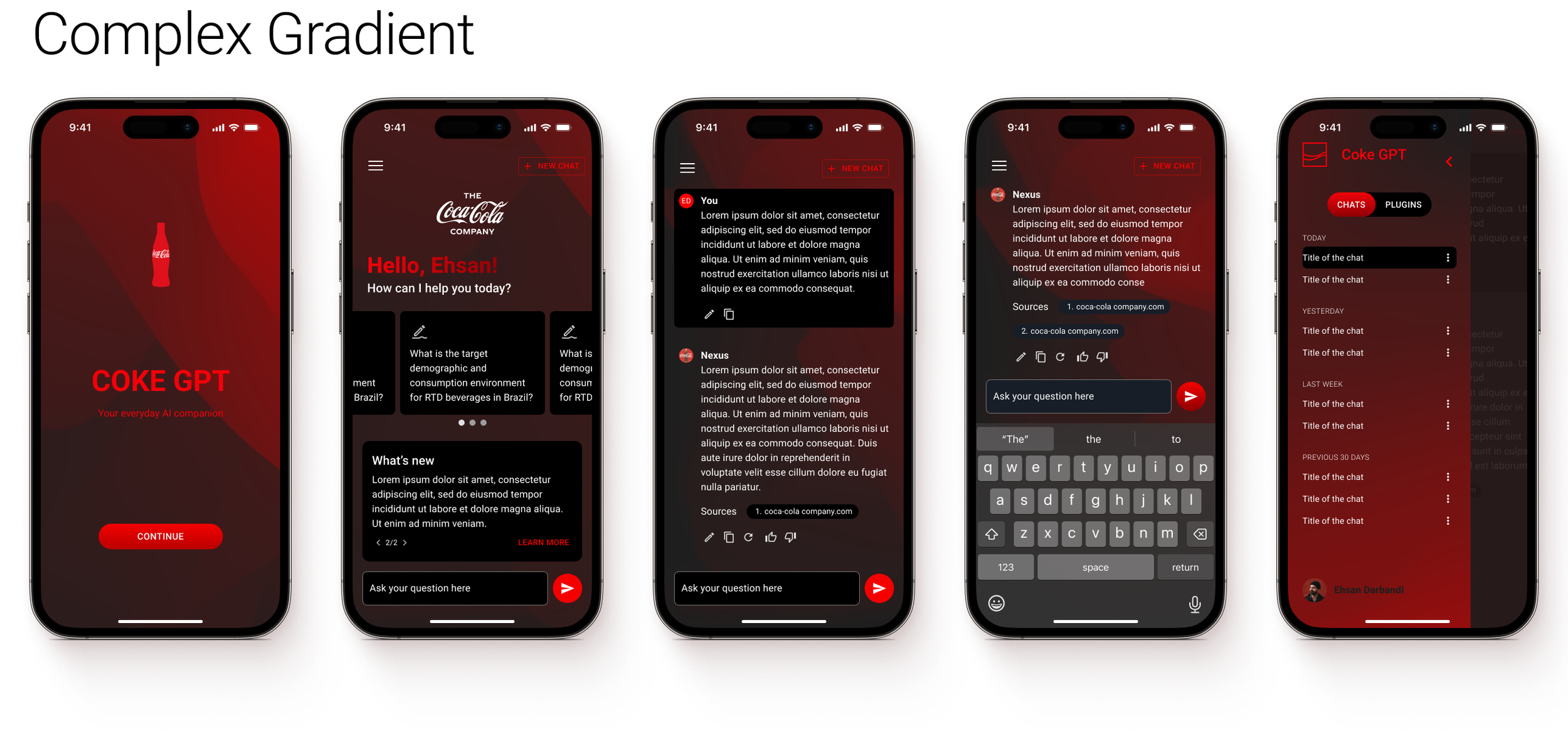Nexus AI
A Unified, Intuitive AI Experience for Coca-Cola employees
The Nexus AI project is an internal initiative at Coca-Cola designed to create an intuitive, branded interface that empowers employees to confidently adopt AI in their daily work. Nexus AI serves as an entry point for non-technical users to access, learn, and adopt AI in their daily workflows, while ensuring consistency with Coca-Cola’s brand and design standards.
Through a branding audit, stakeholder workshops, and competitor analysis, we identified the challenges employees faced when navigating multiple disconnected AI tools. We designed a scalable design system and an intuitive chat-based interface that simplified onboarding and provided a familiar, approachable way to interact with AI.
Stake Holders
2 PMs
2 Business Analysts
4 Engineers
1 Software Architect
1 Product owner
Solution
The final design introduced:
Nexus AI Platform – A centralized entry point for employees to access and adopt AI.
Unified Design System – A scalable system tailored to Coca-Cola’s brand, enabling future AI tools to plug in seamlessly.
Chat-Based Interface – Simplified interactions through natural language, making AI approachable for non-technical users.
Document Upload Feature – Allowed employees to provide context for more accurate answers, improving trust and efficiency.
Role
UX and UI designer
Skills
Industry Analysis, Brand Audit, Design Strategy, Prototyping, Usability Testing, Visual Design, Design System Creation
Approach
I partnered with engineering and product stakeholders from day one to build a solution in parallel with development. My process included:
Brand & UX Audit – Assessed Coca-Cola’s existing digital ecosystem and visual identity to ensure alignment with established design language.
Competitive Research – Studied leading conversational AI platforms to identify usability patterns and gaps.
Rapid Prototyping – Iterated on flows and components in Figma, ensuring solutions could be built within the tight engineering timeline.
Kickoff & Stakeholder Alignment
At the start of the project, I partnered with the product owner and two cross-functional teams working in different time zones to ensure deadlines could be met. A senior stakeholder emphasized the need for a design that felt impressive and strongly aligned with Coca-Cola’s brand identity. At the same time, the engineering teams required a solution that was simple enough to begin building the following week. To align everyone quickly, I synthesized the requirements and reviewed all available Coca-Cola brand resources. I spoke with other internal design teams to understand how they approached and maintained design consistency. This early alignment provided the foundation for moving into research and design with clarity and speed.
Increase onboarding
Increase Efficiency
Build confidence in AI
Maintain brand integrity
Coca-Cola Brand Discovery
Through my brand audit, I uncovered several challenges that shaped the design direction for Nexus AI. Coca-Cola’s digital presence felt fragmented, with the main site blending the master brand and 35+ sub-brands in ways that created a visually crowded and sometimes inconsistent experience. I also found that design resources were limited, with sparse documentation and inconsistent guidelines for digital applications, which made it difficult for designers to build upon a unified foundation. Finally, the diversity of sub-brand identities added another layer of complexity, as each carried its own look and feel. These insights highlighted the need for a centralized design system that could bring cohesion, streamline assets, and ensure Nexus AI reflected the strength of Coca-Cola’s master brand.
Competitive & Comparative Analysis
As part of my process, I analyzed leading AI tools such as ChatGPT, Gemini, and Copilot to identify common patterns and user expectations. These products set a clear standard with chat-based interfaces, simple layouts, and guided onboarding that make them easy to use. To help Coca-Cola employees feel comfortable and adopt Nexus AI quickly, I decided to follow these familiar patterns as the foundation. For features that other tools did not cover, like uploading documents for more accurate answers, I created new user flows and wireframes that fit our needs. This approach kept the design intuitive while still adding unique value for Coca-Cola.
Conversational: Excels at casual conversation and creative writing.
Versatility: Handles various tasks like code debugging and writing different content formats.
Limited Integration: Primarily a standalone web app, lacking integration with other tools.
Accessibility: Interface might be overwhelming for new users due to its focus on open-ended prompts.
Lacks source attribution: doesn't provide sources for its responses, hindering credibility for factual inquiries.
Accessibility: Straightforward interface with clear prompts and functionalities.
Search Integration: Seamlessly integrates with search engines for fact-checking and research.
Focus: Leans more towards information retrieval and completion than open-ended conversation.
Limited Creativity: May struggle with highly creative writing prompts compared to ChatGPT.
Basic UI: may appear uninspired or lack visual appeal.
Deep Integration: Integrates directly with developer environments like Visual Studio Code, boosting workflow.
Task-Specific: Tailored towards code completion and suggestion.
Inconsistent responsiveness: UI elements may disappear on smaller screens, creating a frustrating user experience.
Learning Curve: New users may find Co-Pilot overwhelming due to its extensive features.
Inconsistent Intuitive Interaction: Some interactions are not as intuitive as expected. Users may encounter unexpected behavior.
Design Exploration
After converging on the requirements, I explored a wide range of design possibilities, drawing from current trends such as glassmorphism, dark and gradient UIs, bold typography, and minimal interfaces. I created more than five high-fidelity mockups that represented these directions and reviewed them with leadership, product owners, product managers, and engineers. The head of design had emphasized the importance of delivering a “wow factor” that reflected Coca-Cola’s future design vision, so the explorations were intentionally ambitious and visually distinct. However, during stakeholder reviews, we aligned on the need for a more minimal, scalable solution that could be implemented quickly within the project’s tight timeline and limited development resources. This process ensured we balanced innovation with practicality, delivering a design that was both inspiring and achievable.




Strategy & UX Foundations
To define the core features of Nexus AI, I led multiple working sessions with stakeholders to evaluate priorities such as document upload, conversation history, and inline sources. Rather than just listing features, I translated options into clickable prototypes, which allowed stakeholders to experience the flow and quickly align on the final set of must-haves. Once features were defined, I mapped out the key user flows, starting conversations, uploading files, and retrieving answers, through interactive prototypes that conveyed both the look and feel of the potential designs. My focus was on delivering a system that balanced speed and adoption with enough flexibility to scale as future features were introduced.
Familiar Conversation PatternAll three rely on a clean, chat-style interface. users expect a text-first, two-pane layout (prompt on bottom, history on top).
Expandable FeaturesPlugins, file uploads, and multi-modal inputs are emerging as standard for users.
Guided Onboarding Subtle tooltips, example prompts, and quick-start templates help first-time users gain confidence.Minimal Visual Distraction Neutral color palettes and generous whitespace keep focus on the dialogue.
Design System & Visual Language
To ensure consistency and scalability, I built a lightweight design system tailored to Nexus AI. I started by auditing Coca-Cola’s existing brand assets and design language, then extended them into reusable components, patterns, and guidelines that aligned with both Coca-Cola’s identity and the needs of an AI interface. Since development resources were limited, I prioritized simplicity and modularity, making sure the system could be implemented quickly without sacrificing brand integrity. The result was a visual language that felt unmistakably Coca-Cola. Providing a foundation that the team could build on as the product evolved.
Context & Memory CuesFeatures like conversation history and inline references improve trust and usability.Cross-Device ConsistencySeamless experiences across desktop, mobile, and web apps set user expectations for a responsive, flexible design.
Industry Standards Analysis and Best Practices
Outcome Highlights
Delivered on time and met all project expectations.
Received positive feedback from stakeholders and leadership for clarity and usability.
Development process ran smoothly with minimal confusion or delays.
Created a scalable design system later adopted for other Coca-Cola AI tools.
Improved employee adoption and trust in Nexus AI.
Balanced innovation with practical execution under strict timelines and limited resources.
Design Reflections
Clear communication is essential for stakeholder alignment, buy-in, and managing expectations.
Great design focuses on clarity, usability, and empowering teams, not just visual complexity.








